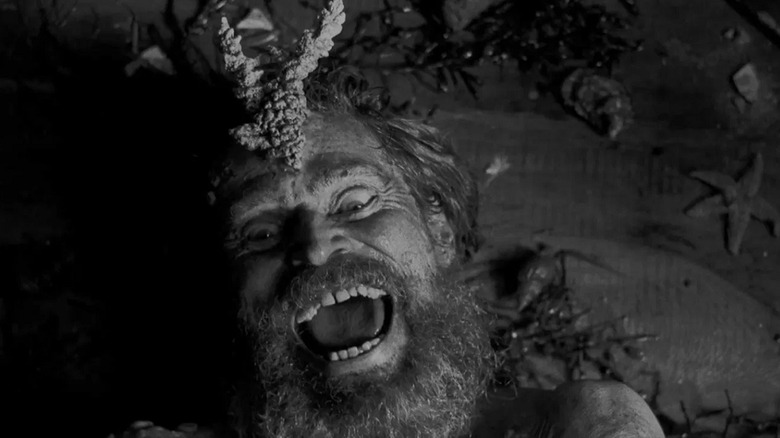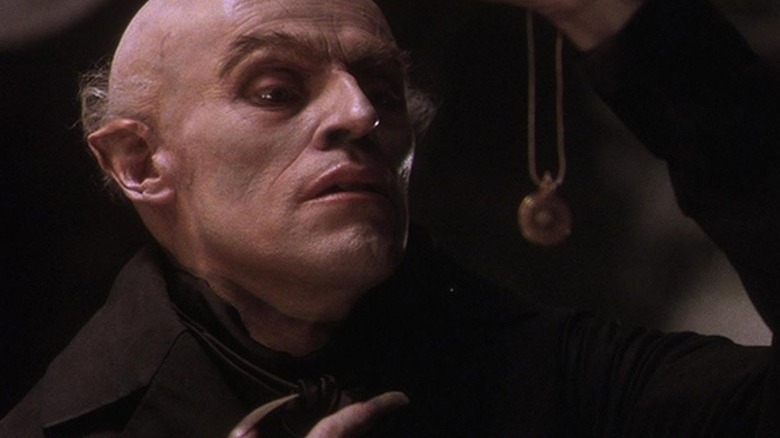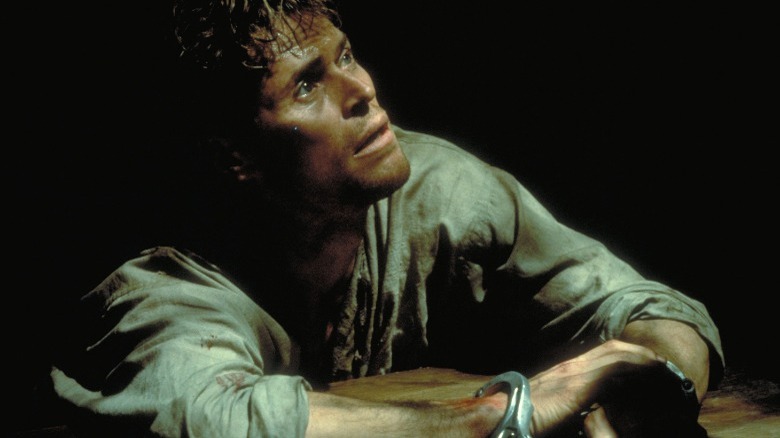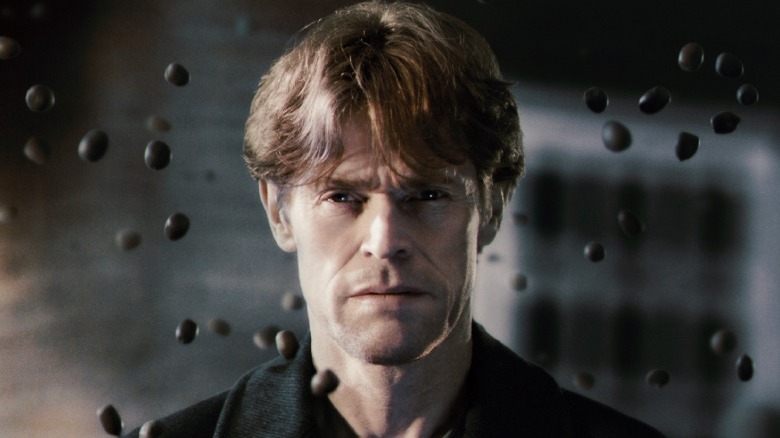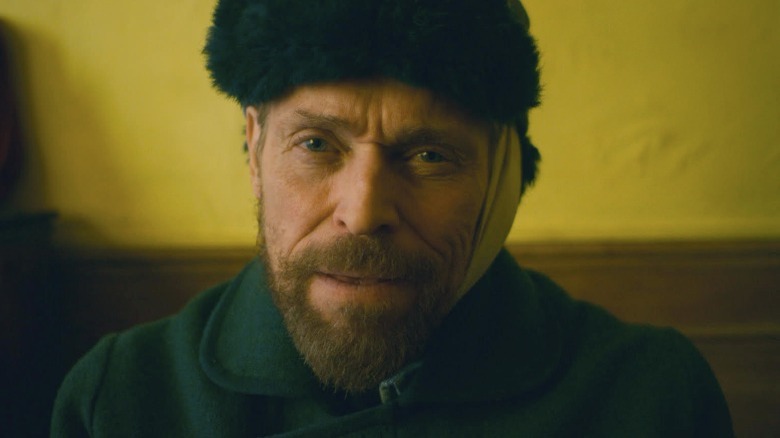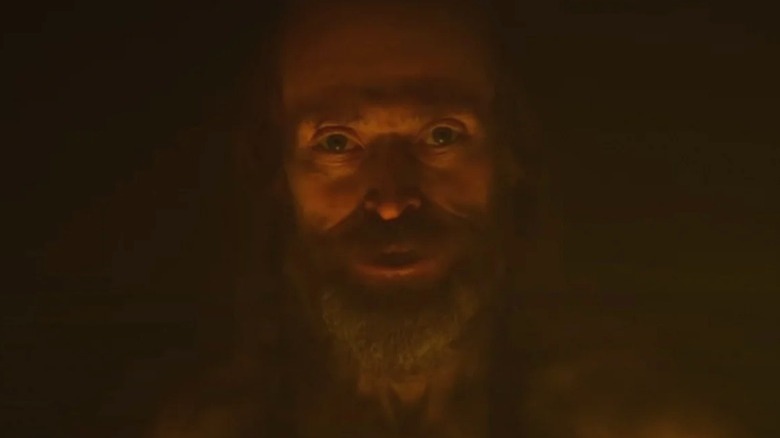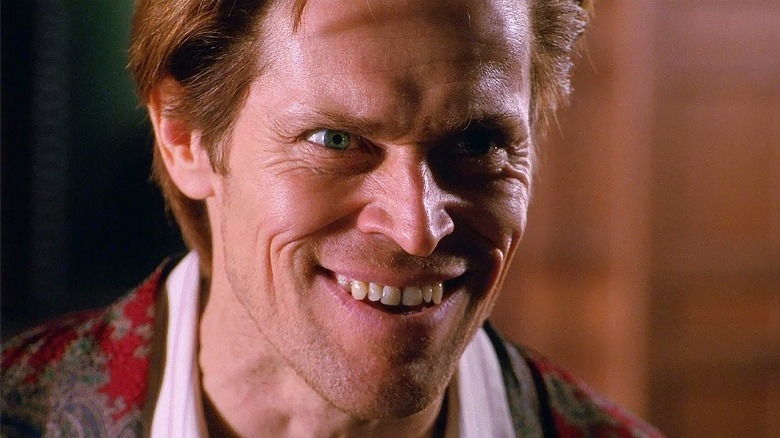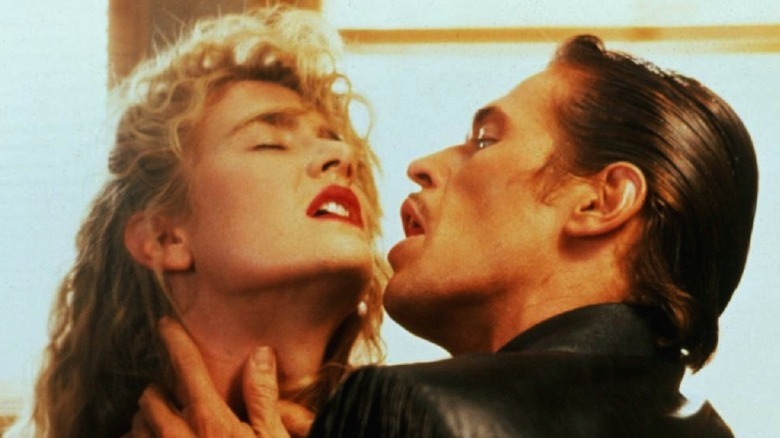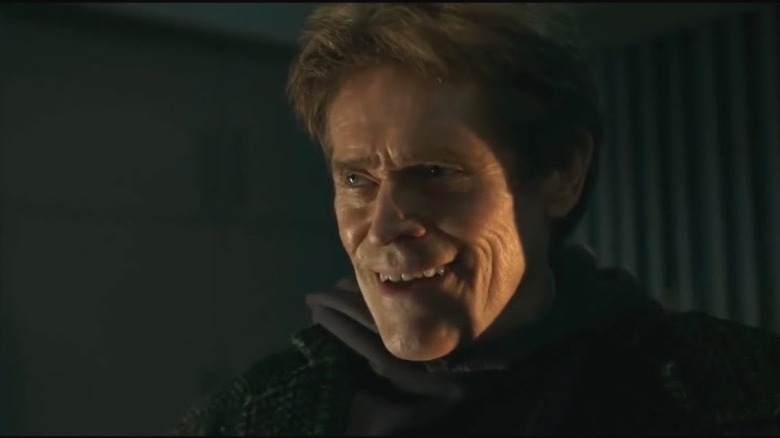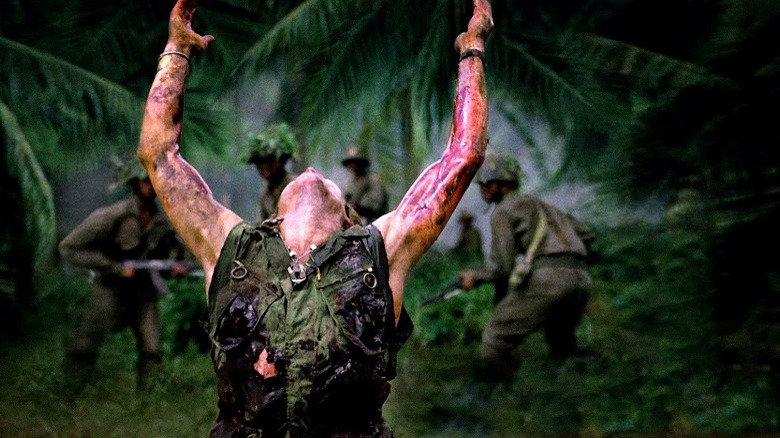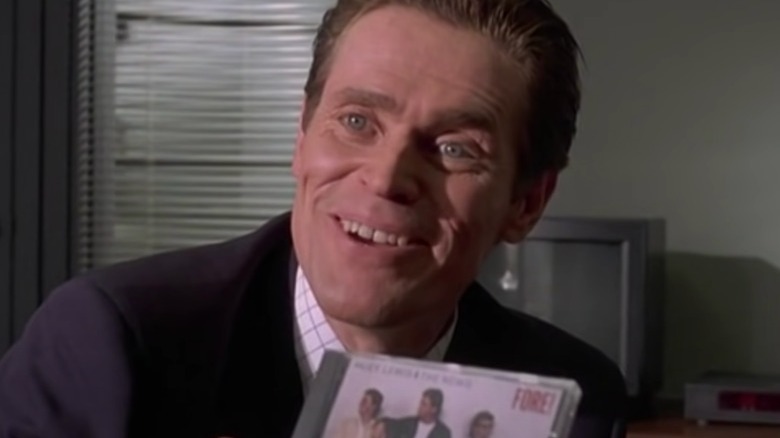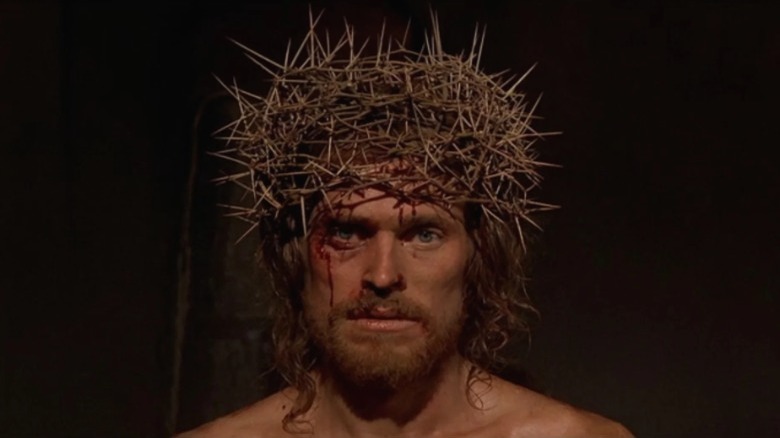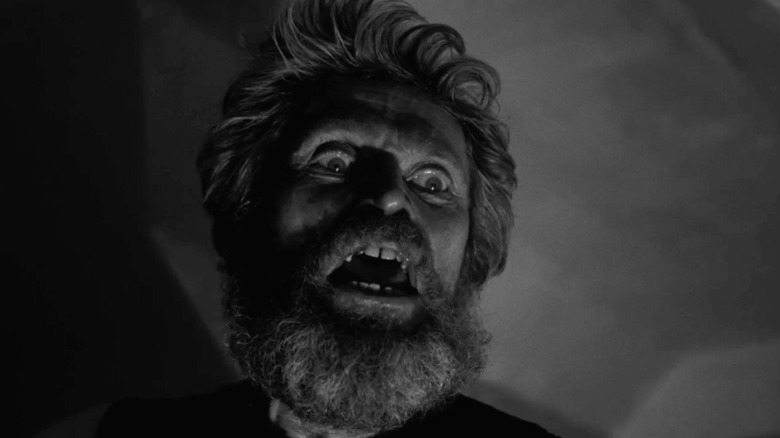The 12 Best Willem Dafoe Movie Moments, Ranked
Don't call it a comeback, Willem Dafoe's been here for years. His recent streak of phenomenal roles, which includes appearances in everything from Robert Eggers' wild masterpieces to a surprise return to his classic supervillain role, highlights what hardcore movie fans have known since the 1982 cult biker movie "The Loveless." Saying "this man can act" is underselling it. Willem Dafoe imbues his roles with passion and effort. A master of the craft, he is an all-in collaborator on the set. It doesn't matter if he's voicing a grumpy tropical fish or a multi-limbed Martian, Dafoe always puts his best face forward.
It's a remarkable face, and he can do a shocking amount with that square jaw and those expressive eyes. Attractive, repellant, contemplative, and, sometimes, straight-up hilarious, I'm not sure there's anything Dafoe can't do to master a role. If he can't fake it, he'll make it. He learned how to paint like the master himself in the Vincent van Gogh biography "At Eternity's Gate," and he did his own stunts whenever possible for "Spider-Man: No Way Home" ensuring his Norman Osborn would transcend his memeable potential. What we're about to list are 12 of Willem Dafoe's very best performances, moments that make great movies into something magical.
12. The arrival of Count Orlok — Shadow of the Vampire
The premise of "Shadow of the Vampire" is so absurd that you'd be forgiven for thinking it was a meta-comedy. F.W. Murnau (John Malkovich), the director of the landmark silent horror film "Nosferatu," hires reclusive actor Max Schreck (Willem Dafoe) to be his star. That much actually happened, but director E. Elias Merhige adds a twist to the tale. Max is an honest-to-God vampire, Murnau's paying him in blood, and everyone else thinks their creepy star is really into Method Acting.
"Nosferatu" is a silent film, and our introduction to Orlok is muted. Orlok slips out from the trees to gesture at his co-lead, Gustav von Wangenheim (Eddie Izzard), to follow him deeper into the dark. First impressions are the most important, and the sight of this misshapen figure Murnau has hired puts the rest of the crew on edge. It's so brief, so quiet. Yet, the sheer weight of Dafoe's presence elicits exactly what the film needs to become both an effective horror film and a biting (har) satire. This film was part of Dafoe's comeback after a string of '90s flops, and it's an unmissable horror classic.
11. Don't cut me — The English Patient
Today, "The English Patient" can try the nerves of anyone not feeling its glacial pace and heavy '90s melodrama, but this award-winning film still has two things going for it: its breathtaking cinematography and its excellent performances — including Dafoe's. As David Caravaggio, a former intelligence operative, he's the closest thing to an enemy that Almásy (Ralph Fiennes) has.
Caravaggio is the wounded nobleman's vengeful mirror, but like him, he's complicated. As he tells Almásy, via grimy flashback, he's captured and tortured. Dafoe plays the scene through an escalating scale of emotions, from defiance to fear to a child's desperate begging. Nothing stops his torturer from cutting off his thumbs. The end of the flashback cuts back to Caravaggio now, stoic again, content in his vengeance. He suspects the burned man in the bed is his final target, the last link in a chain of betrayals that led to Caravaggio's being maimed. All that can save Almásy is the truth, which Caravaggio already knows: Nothing can return to us what was lost. All that's left is what's ahead. Dafoe makes us understand when it's time to let go. He's the dark heart of the film and its most necessary character.
10. Chaos reigns — Antichrist
Lars von Trier is an acquired taste on the level of balut. There's something compelling to be found in the experience, but boy is there an off-putting crunch! "Antichrist" isn't his most mainstream film — I don't think he has a mainstream film — but it sure is trying to say something about the unfathomable pits of darkness inside us.
Willem Dafoe is our lead, a nameless guy trying to make sense of the world after he and his wife (Charlotte Gainsbourg) lose their son. They return to a warped idea of Eden and begin a reconstruction of the coupling of Adam and Eve. There are hints that this is going in a bad direction, but the film offers a full warning when it turns to horror. Dafoe finds a reflection of himself in a fox that's tearing itself open, and his shock and the fox's pronouncement that "chaos reigns" offer one of the film's few keys to understanding. It's his voice coming from the fox, his human experience he's tearing wide, all under the eye of a cynical view of humanity's origins. Von Trier conceived this story under treatment for depression. It takes Dafoe and this scene to make something legible and even compelling out of von Trier's nightmare.
If you or someone you know needs help with mental health, please contact the Crisis Text Line by texting HOME to 741741, call the National Alliance on Mental Illness helpline at 1-800-950-NAMI (6264), or visit the National Institute of Mental Health website.
9. I am my paintings — At Eternity's Gate
There is nothing wrong with admitting you haven't seen whatever movie the cinephiles are raving about. Almost nobody saw "At Eternity's Gate" at release, ending its theatrical tour with a worldwide gross of under $11 million. Nevertheless, everyone's seen the meme of Willem Dafoe's distorted Van Gogh staring up through the blue in confusion, terror, and awe. Give the movie a chance to explain why he's doing it. It's beautiful.
Van Gogh's ear is already gone when he sits with Doctor Ray (Vladimir Consigny) to assess his mental health. His head is wrapped in a bandage, he's wearing his signature hat, and his favorite shade of yellow fills the wall behind him. Ray is gentle but firm as he questions Van Gogh about his art. Dafoe portrays the artist's confusion with gentle veracity. He is his paintings, they're his soul, and they are the closest he can get to showing the world what he sees. That the world is beautiful in all its turmoil and complexity and vigor. Dafoe's empathetic performance makes this film perfect. It's one of his most sensitive, and this signature scene is key.
8. The ritual — The Northman
Willem Dafoe, as Heimir, is the Yorick-styled fool of King Aurvandill's (Ethan Hawke) Hamletian high court, but this fool is a wise man who knows he's a fool, another Shakespearean borrow that itself is both Biblical and Buddhist. Heimir also seems to be the king's he-witch, and he's the one overseeing the shamanic ritual that makes Amleth's fate a fixed point.
Dafoe imbues the dreamlike sequence with mythic intent. The king and his young son scramble along the floor like dogs, and it's Heimir's earthy ritual, flatulence and all, that reminds them both how to ascend to man's destiny — and mortality. Amleth will be king, and it will be his duty to honor his family, even against disaster. There's the ominous sense that both Heimir and Aurvandill know what's going to happen the moment they leave the ritual tent, and Amleth is their unwitting weapon of revenge. Most importantly, Eggers gives Dafoe another magnificent scene that reminds us why Dafoe is one of the best actors in the industry.
7. Norman Osborn confronts the mirror — Spider-Man 2002
After viewing "The Last Temptation of Christ" director Sergio Leone said of Willem Dafoe: "This is the face of a psychopathic killer, not the face of Our Lord." Rude but also prescient. In Sam Raimi's "Spider-Man," Dafoe plays the infamous Marvel industrialist and founder of Oscorp, Norman Osborn. He also plays the infamous villain Green Goblin. With Dafoe in charge of the tightwire act, these are two distinct characters occupying one body.
This is highlighted in a masterful sequence. Norman is at home, robed comfortably as he roams a room of trophies. Masks and mirrors pepper the room. Norman is threatened by an unseen entity, and it reveals its familiar, angular face in those mirrors. Dafoe makes it easy to determine which entity is talking. Norman is horrified, his brows knitted, his voice softer, his veneered teeth harmless. The Goblin growls when he talks, showing Dafoe's naturally off-kilter teeth, and he's practically looming out the mirror towards his other self. The Green Goblin, a goofy besuited icon of classic Marvel is terrifying in this reimagining. And Dafoe's childlike terror reveals that his first victim is Norman Osborn.
6. Bobby Peru terrifies Lulu — Wild at Heart
"Wild at Heart" is a black comedy the way "Salo" is about boys being boys. Recognizing it as a masterpiece of the Theatre of the Grotesque takes more work to explain. Our stars are Ripley, played by Nicolas Cage, and Laura Dern as Lula Pace Fortune. They're young lovers on the run in a David Lynch movie, which means nothing goes well, and everything is weird. That includes Willem Dafoe, who was probably born knowing what a Grotesque is.
Dafoe is Bobby Peru, a gangster. He's horrible to behold, with a face that looks like it's been waxed tight, a pencil-thin porn 'stache, and a set of teeth you can smell through the screen. It's the scene in which he busts in on Lula that lingers in our terrified brains. Lula's on the defensive while Dafoe sleazes his way through a disgusting monologue, threatening violence unless she asks him for sex. It's upsetting stuff that requires a warning for victims of sexual violence, which Lula is. Dafoe handles the tonal changes from moment to moment like it's an opera. It's difficult to laud a man for portraying a creep like this, but Bobby Peru is one of Lynch's best characters, and this is his big moment.
If you or anyone you know has been a victim of sexual assault, help is available. Visit the Rape, Abuse & Incest National Network website or contact RAINN's National Helpline at 1-800-656-HOPE (4673).
5. Norman's on Sabbatical, honey — Spider-Man: No Way Home
Setting aside our glee at the Raimiverse coming home to MCU canon, "Spider-Man: No Way Home" deserves praise for letting its villainous ensemble be their very best — and their very worst. The theme of redemption rolls hard throughout the movie, and we're rooting for Norman Osborn's control over the body he shares with the Green Goblin. Dafoe doesn't miss a beat in evolving his portrayal of this tortured mind, and now there are extra twists in trying to tell if Osborn is still in control. We hope he is, but we fear he's not.
Tom Holland's Spidey is in the same fix, but by now, he's learned to trust his instincts. His plan to rehabilitate these villains before sending them home comes from a good place, but the Goblin wants to keep his toys. That's revealed when Peter's spider-sense reacts to Norman, who reveals the Goblin's been listening all this time, waiting to take over the "coward" when the moment is right. He woos most of the remaining villains to his side in a pure Dafoe-fueled menacing monologue, and that's the moment this fun movie earns an edge that elevates it into something more.
4. Elias' death — Platoon
Oliver Stone's breakthrough movie, "Platoon," is a top-10 war movie in its own right. There's nothing joyful about it. It contains the plain-language dichotomy of idealism vs. cynicism, and a casual understanding of the Vietnam War tells you which side wins. Charlie Sheen stars as Taylor, a soldier caught between the representatives of these ideas. Tom Berenger is the pessimistic Barnes, and Dafoe is Elias, a man who can still be kind.
Vietnam was an insensate war fostered by the U.S. that ruined generations of people, Vietnamese and American. You rarely came home the same, if at all. Elias doesn't make it because Barnes, a brutalist with a god complex, won't let him. To cover up his men's worst actions, Barnes takes the opportunity to shoot Elias and tells the platoon it was fatal during extraction. However, Elias, like hope, is hard to kill, and the scene of him running with the enemy behind him is the central image of the film and why it took Best Picture at the Academy. Dafoe's anguish as he's gunned down feels real, a preview of his tortured Jesus two years later. He falls to his knees, his arms spread in a cry to heaven. It's phenomenal.
3. The interrogation - American Psycho
"American Psycho" works as another Grotesque because we're forced into the viewpoint of Patrick Bateman (Christian Bale). Like him, we're never quite sure of the truth of our perceptions, and it's bleakly funny stuff. Bateman is beyond unreliable. He needs professional help because he thinks he's a serial killer. Maybe he is. It's that doubt that puts him in conflict with private detective Donald Kimball (Willem Dafoe), who's investigating the possible disappearance of one of Bateman's colleagues.
We (and Patrick) are unsure how to take Kimball, and that's on purpose. Director Mary Harron filmed Kimball's initial interrogation three times in full. In each take, Dafoe offered an entirely different tone in his interaction with Bateman. The result is artful befuddlement, as Dafoe is switching between inquisitive, sketchy, and confident with every cut as Harron splices the various takes together. It'd be fascinating to watch each version of the interrogation from beginning to end to compare Dafoe's ability to make his intentions clear and distinct each time. There's no doubt it'd be a masterclass.
2. The crown of thorns — The Last Temptation of Christ
Set aside personal questions of faith. "The Last Temptation of Christ" is an emotional exploration of the idea of Jesus. Its most controversial act is to give him the humanity he was meant to experience with all its flaws. Its second controversy is casting Willem Dafoe as the Son of God. His unique features make Jesus remarkable, but it's his talent that makes us believe in Christ's pain.
The Passion refers to the final days of Jesus' life after he arrives in Jerusalem. It's the torture he undergoes that shapes iconography. Naked and agonized, Dafoe as Christ is scourged by the Roman guards. The crown of thorns is forced onto his brow. The rest is harrowing, but the signature shot is of Dafoe's Christ, bloody but aware, limned by the sun. It's not a lack of expression in his eyes, it's every expression all at once. The realization that he is the Son of God, and this is his fate. It's a powerful sequence, followed by the Via Dolorosa.
This scene highlights what comes next, the temptation laid before him by Satan (Harvey Keitel). Be humanity's savior and die in holy agony or be a man and live a simple life.
1. HARK! — The Lighthouse
We've all tried to memorize Dafoe's crowning cinematic moment in Robert Eggers' "The Lighthouse." Maybe we've gotten close, but none of us can match the manic energy or the unblinking stare Dafoe adds to his performance as lighthouse keeper Thomas Wake. The curse Wake lays on Winslow (Robert Pattinson) is over two minutes of lyrically invoking Triton, god of the seas, to whip this kid's ass because he committed the crime of not liking Wake's cooking.
There's some mood whiplash and real comedy when we're reminded that this is what it's over — with Winslow's subdued appeasement of Wake. Despite the tension-relieving chuckle, nobody believes Winslow likes Wake's cooking, nor that this is what this is really about. Yet, Wake's hellish monologue, his face cast in shadow, helps the unearthly discomfort that's long since settled in. Is Wake something more than a wickie? Is he an old man gone mad due to the loneliness of the seas? Or is he truly Proteus, the Old Man of the Sea, fortune-teller kin to Poseidon? The beauty of Dafoe's performance is that he's all this at once and possibly more.
